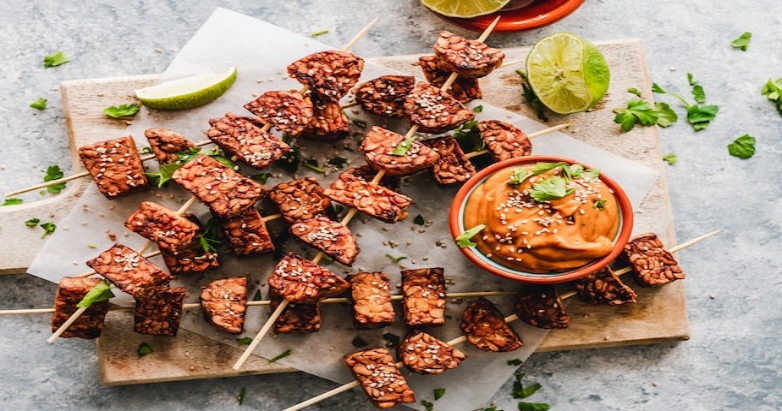
It’s no secret that diet plays a role in many religious traditions. For example, many people in the west understand that certain foods aren’t kosher and know Muslims fast during Ramadan. Adhering to these rules is an important part of showing faith for many of the devout.
However, some traditions also confer decided health benefits. It’s likely most originally did. After all, eating practices arose from indulging in locally available foods that made you feel better while shunning those that make you sick. Early people may not have known about trichinellosis, but several faiths prohibit eating pork, the meat most likely to infect you with the parasite. It’s possible early religious leaders made the connection between consuming the flesh and illness and enacted the ban to protect their people.
Many westerners don’t know much about Buddhism, but making food choices like a monk could help you improve your overall health. Here’s how to eat like a Buddhist and some traditional Buddhist food recipes to get you started on your journey.
How to Eat Like a Buddhist
Buddhists adhere largely to a plant-based diet. Such meal plans are rich in nuts, seeds, vegetables, fruits, whole grains and legumes and may include limited animal products such as dairy and eggs. Therefore, your first stop to adopting this eating plan is to start with meatless Monday and reduce your consumption of beef, pork and chicken from there.
Why do Buddhists choose such a diet? While Buddhists accept that suffering is a part of life, they also believe that the goal of dharma is to reduce the greed, anger and delusion that give rise to samsara. This belief extends to all living beings, including animals. Therefore, they don’t participate in practices like hunting or consuming the products of factory farms that cause harm to those with fins and fur. However, traveling monks may accept offerings of meat when proffered.
Health Benefits of the Buddhist Diet
While some evolutionary biologists argue that humans would never have evolved to their present state without consuming meat, modern intake increases health risks. For example, the World Health Organization considers processed meat a carcinogen and red meat a probable one. They recommend eliminating the consumption of foods like bacon or reducing them to prevent colorectal cancer in particular.
Furthermore, the Buddhist emphasis on dharma and reducing suffering leads many practitioners to reduce their reliance on ultra-processed foods, which have decided health risks for individuals — and the planet. Each step in the manufacturing chain requires energy, which increases emissions. Conversely, buying locally-grown fruits and vegetables minimizes the environmental impact of each meal.
Ultra-processed foods don’t just increase the suffering caused by global warming. They also harm human health. For example, they contribute to the soaring rates of Type 2 diabetes among Americans.
Nearly 100 million Americans have prediabetes or the condition itself, which often requires ongoing medical care. Much of the fault lies in the overconsumption of ultra-processed foods rich in added sugar and white flour.
White flour is problematic for two reasons. Manufacturers strip away the fiber-rich bran and chaff, leaving a substance that absorbs quickly and spikes blood sugar. As if that effect isn’t enough, bleaching creates a chemical byproduct called alloxan that scientists use to destroy the pancreas of laboratory animals. Your pancreas makes insulin, which your body needs to manage your glucose levels.
5 Traditional Buddhist Food Recipes
You’ve decided you want to learn how to eat like a Buddhist while mindfully observing the health effects. Good for you. Here are five traditional Buddhist food recipes to help you dig into the lifestyle.
1. Tofu-Okra Miso Soup
Western bellies may turn to chicken soup when they feel under the weather. However, folks who walk the Buddhist path often choose miso and not only because it’s free of animal products. Miso is a fermented soy product, which makes it rich in probiotics that nourish your intestinal microbiota. What does your belly have to do with a cold? It turns out the good bacteria in your gut sends signals to your immune system and boosting their levels could help you feel better.
This recipe contains only four small ingredients, making it a snap to assemble even if you feel under the weather. It also has okra, which is rich in fiber. Fiber is prebiotic, which nourishes the healthy bacteria in your intestines, keeping them running smoothly.
2. Tempeh With Spicy Peanut Sauce
What is tempeh? It’s similar to tofu, although this mixture is a slightly fermented blend of soybeans, which gives it different health benefits. You get many of the same probiotic perks of miso, and it’s high in plant-based protein. The peanuts provide yet another source of the muscle-building stuff.
Like many stir-fry meals, this recipe cooks up in less than 15 minutes once you assemble the ingredients. You can serve it over white rice, but substitute wild or brown for additional filling fiber. The sriracha gives this dinner a bit of kick if you like things spicy.
3. Butterbur and Egg-Stuffed Tofu Pockets
Butterbur may seem like an unusual ingredient. If you’re a migraine sufferer, you might know this plant better as a supplement, but it also tastes delicious.
This recipe also contains egg, so it isn’t appropriate for the vegan crowd. However, it delivers an added protein punch for lacto-ovo vegetarians. If you worry about the treatment of chickens on factory farms, why not get your stash from your local farmers market? You can chat with the folks who raise the hens, assuring yourself that their cultivation methods don’t result in unnecessary cruelty.
4. Tibetan Noodle Soup
Here’s a super healthy meal you may wish to make ahead and keep in your freezer for cold days. It’s chock-full of various veggies that are vital to good health. If you strive to eat the rainbow each day, this recipe deserves a spot on your menu.
If you don’t want to make noodles from scratch, you can substitute store-bought versions. Why not try delicate thin rice noodles added after you defrost the broth? Alternatively, make a heartier meal with chickpea noodles that stick to your ribs with a protein punch.
5. Vegetarian Lettuce Wraps
Lettuce wraps make a tasty alternative to sandwiches. You also reduce your reliance on white bread and increase your vegetable intake. Although all veggies contain carbs, those in your wrap will have far fewer net per serving than a slice of Wonder Bread.
This recipe harvests the goodness of corn and avocado. It’s a bit of a southwest twist on a traditional Asian dish.
Buddhist Diet: How to Eat Like a Buddhist and Traditional Recipes
Various religious faiths adhere to different dietary restrictions as a part of their rituals. However, many of these practices also improve your health.
Now that you know how to eat like a Buddhist, why not add some of these traditional Buddhist food recipes to your weekly menu? You’ll improve your well-being and treat your taste buds to welcome variety.












